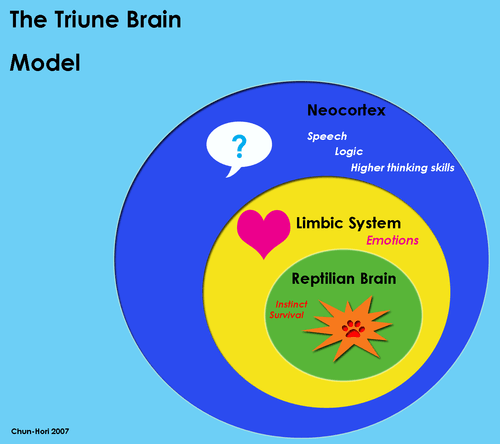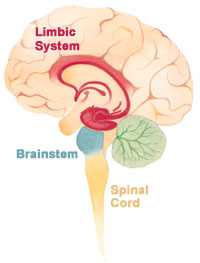Motivation and emotion/Tutorials/Needs
< Motivation and emotion < TutorialsTutorial 02: Needs
| |
Resource type: this resource contains a tutorial or tutorial notes. |
This is the second tutorial for the Motivation and emotion unit of study.
Physiological aspects of motivation and emotion
Important physiological elements of our motivational and emotional experiences include brain structures, hormones, and neurotransmitters. Whilst each of these components serves particular goals, the elements communicate directly or indirectly with one another to work dynamically and holistically.
Brain
Brain structures important to understanding our motivational and emotional can be conceptualised useful within the triune theory, with arousal/alertness functions in the brain stem, survival and emotional functions in the limbic system, and higher order capacities to self-regulate, plan, make choices, exercise volition, decide whether to approach or avoid, and so on operating in the frontal cortex.
Triune brain theory

- What is it?
- What are the layers?
- What is their function?
- What does the triune brain theory tell us about motivation and emotion?
- What does science say about the triune brain theory?
Brain structures

Activity: In small groups
- Match the brain structures to their functions - do the best you can, then check against the answers
- Mix them up, and try again - repeat until your group can get them all right
- List of brain structures
- Overview (Shows brain diagram with structures marked)
- Reticular formation
- Medial forebrain bundle
- Hypothalamus
- Amygdala - Video
- Septal area
- Hippocampus
- Cerebral cortex (Frontal lobes)
Hormones
- Ask/discuss:
- What is a hormone?
- Allocate each person a hormone (or a function of these) - from this list.
- Invite class to 'find their match' and discuss what they know about how this physiological element works. (If someone is really lost, encouraged others to help them out; last resort - give them a hint)
- Ask the pairs to explain their match to the class and what else they know about that hormone; encourage other's input
- Optional: Mix-up and repeat again.
- List of hormones
Neurotransmitters
- Ask/discuss:
- What is a neurotransmitter?
- Allocate each person a neurotransmitter (or a function of these) - from this list.
- Invite class to 'find their match' and discuss what they know about how this physiological element works. (If someone is really lost, encouraged others to help them out; last resort - give them a hint)
- Ask the pairs to explain their match to the class and what else they know about that neurotransmitter; encourage other's input
- Optional: Mix-up and repeat again.
- List of neurotransmitters
Needs
As a whole class, brainstorm:
- What are needs?
Discuss and define - needs are requirements for physiological and psychological health and well-being. - How do needs differ from desires, wants, likes etc.?
Needs are essential for survival and well-being; desires, wants, likes etc. are motivations for non-essential stimuli (e.g., An umbrella in the rain) - What types of needs are there?
Brainstorm. Reeve (2009) suggests that there are physiological, psychological and social needs.
Psychological needs
Self Determination Theory
- Provide an overview of Self-Determination Theory (SDT):
- Who has heard of it?
- What they know about it?
- What is the theory for?
- Who is it by?
- What are the key components?
- Autonomy
- Competence
- Relatedness
- Quiz the class a bit further about what it knows about "autonomy" and what might be meant by "autonomy support"?
- Watch the15 min. video, Promoting motivation, health, and excellence (Ed Deci, TEDx) (youtube) and note answers to:
- What is autonomy-based motivation?
- Why does autonomy-based motivation matter?
- How can we faciliate autonomy-based motivation? (e.g., as leaders, managers, teachers, parents)
Book chapter development
Progress so far
- Poll
- Who doesn't have a topic? (sign up or propose a topic by the end of Week 3)
- Discuss/help
Structure and features
As a class, brainstorm and discuss:
- Book chapter structure (main sections)
- Learning features (basically, anything that is not paragraph text)
- Social contribution (any logged contribution beyond one's primary chapter)
Chapter plan development and feedback
- Who has a chapter plan? (should consist of topic (title, sub-title based on a question), main headings, key points, key references, learning features)
- Who has a chapter plan on wiki? (strongly encourage putting a plan up and soliciting feedback - from buddy, from group, from peers, from instructors - e.g., via request on the discussion forum, wiki, twitter etc.)
- Who has received feedback on wiki feedback on a chapter plan? (this will aid your social contribution)
- Who has at least one "wiki buddy"? (each person should know the user name of someone else with whom they've agreed to work for peer review purposes - help students find at least one wiki buddy if they don't already have one)
- By taking the plunge to sketch a plan and getting some feedback on your plan, it will boost your momentum and help to ensure that you have a good structure to guide your chapter development.
- With any extra time at the end of tutorials, invite and encourage any questions about the assessment and then if people ask a useful question, with their permission, bring up their book chapter page on the projector (or Google Scholar etc.) and try to fix/help with whatever they are asking about on their chapter page. That helps to reward and encourage sharing and asking questions as a group.
- Next tutorial we will discuss content development.
See also
- Models which organise needs (Extra tutorial exercise)
- Implicit motives (Extra tutorial exercise)
- Brain and physiological needs (Lecture)
- Psychological and social needs (Lecture)
- Introduction (Previous tutorial)
- Motivation, optimism, and self (Next tutorial)
- Tutorial session notes - Instructor notes
- Oxytocin and emotion (Book chapter)